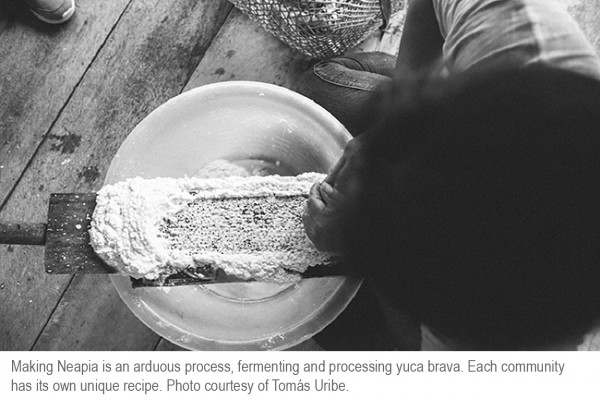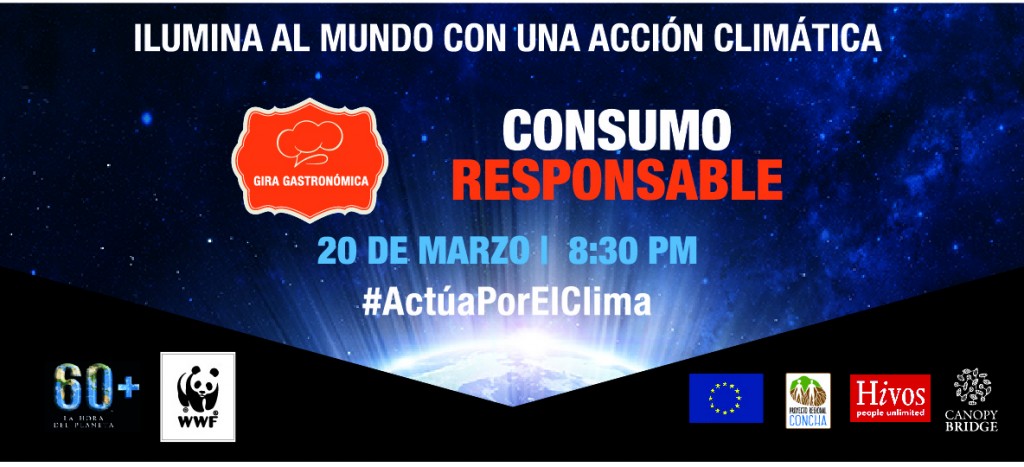What do black outs in 17 historic churches of Quito, Ecuador, Amazonian hot peppers, and conservation have in common? The 2016 Earth Hour in Ecuador, where Amazon products were showcased during the World Wildlife Fund’s iconic event for climate change.
The linchpin of this yearly event is an hour of turning off the lights to conserve energy and raise awareness on the mitigation of climate change. This year’s additional theme for WWF Ecuador was food systems and climate change, and Canopy Bridge supported their message for eating sustainably by adding our own flavor to the night: sustainable gastronomy from the Amazon. Through our initiative “Rainforest to Table,” we were able to include Slow Food Ecuador and a network of Ecuadorian chefs in the event, and thus celebrate this year’s Earth Hour with delicious, sustainable, candlelit dinners. Twenty-two restaurants in Quito, Cuenca, Manta and Saraguro collaborated with us, and have–in addition to making the event a culinary, as well as an environmental delight–now formed a network interested in experimenting with incredible Amazonian products that can provide new flavors for the chefs’ creations. As WWF put it, the evening was a time to turn off the lights, not the kitchens. If anything, we turned up the heat in the restaurants, deciding to source sustainable Amazon hot peppers for the event.

Chilis (or ajíes as they are called in Ecuador) are native to the Amazon, meaning that not only does their sustainable production fail to negatively affect its ecosystems, but it also creates a viable economic means for Amazon communities to earn income without deforestation. These spicy rainforest fruits have been domesticated over millennia in the farms–or chakras– of indigenous communities, becoming a part of a unique culinary heritage throughout the region. By working with community producers from several different ethnic groups, we aimed to highlight the story behind these ingredients and add a new chapter to their role in their Amazon home.
Fresh ají has played an important role in Amazon livelihoods. They were planted around family homes not only to supplement their diets but also to protect their inhabitants from the dangers of the jungle. Hunters used them as a deterrent against predators in the belief that it stung the animal’s eyes to look upon hunters who ate and adorned themselves with the spiciest ajíes. The fresh ajíes for the Earth Hour came from a kichwa family farm near Tena, Ecuador. Kichwa communities in Napo developed many traditional dishes around ají, such as sauce of ají with white cacao, which is used to add flavor and energy to boiled yucca and plantain on rainy days when it was difficult to gather or hunt other foods. Fresh ají forms an important spiritual component in the community, and is used to release negative energy through tears. This is considered a formative process for children, and community elders sometimes place ají in the youngsters’ eyes to help them to mature and to better see the forest and its spirits.

We also connected the chefs with neapia or “ají negro.” This wonderful concoction is made from manioc, using the juices left over from making casave (manioc flat bread) and concentrating its flavor for all kinds of uses in the kitchen. Prepared by different ethnic groups throughout the Amazon, each community has developed their own special recipe, reflecting each group’s ancestral knowledge and stories, for which reason it is recognized by Slow Food’s Ark of Taste as a unique ancestral food. This dish and the stories it tells deserves its own blog, which we will be publishing shortly, but to give you a taste, the neapia that we sourced for the Earth Hour chefs came from a Secoya family from along the Aguarico River in Sucumbios, Ecuador. The long process of fermenting the “yuca dulce” from a root to savory sauce (with a kick of hot peppers at the end) was only a first step in the neapia’s journey as it made its way from the jungle to kitchens all over Ecuador, where chefs tasted this ancestral product (often for the first time), experimented with it, and plated it for customers to enjoy.

So, to go back to the original question, how do blackouts, hot peppers, and conservation link up?…In a sustainable chain connecting production to consumption for a one-of-a-kind Earth Hour event. By turning out the lights and enjoying a meal prepared by these talented, conscientious chefs, we highlighted the importance of eating sustainably, particularly when digging-in to products that support communities, conserve rainforest, mitigate climate change, and that can, through the joy of sharing a good meal, raise awareness of their origins. Sound too good to be true? Have a taste and see!
Recommended Links
[clear]






Great, thanks for sharing this forum topic.Much thanks again. Rhondes